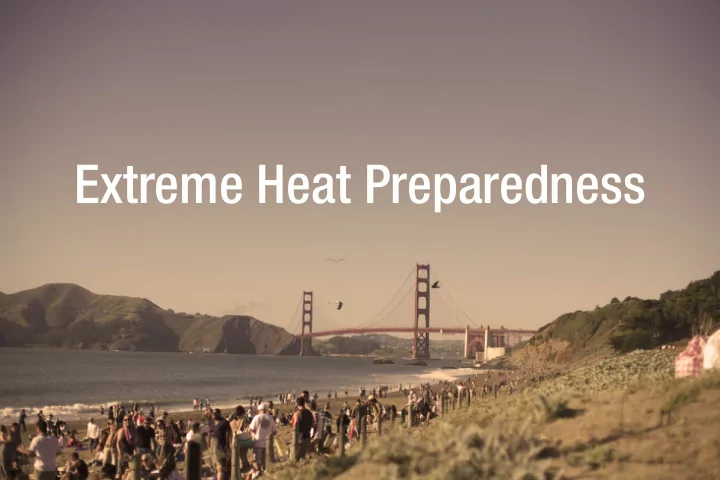

Extreme Heat Preparedness
Objectives What is extreme heat ? How does it impact SF? What are the health effects of heat? How do we prepare for extreme heat?
Extreme Heat in the City “What is extreme heat?”
A Tale of Two Neighborhoods Chicago Heat Wave of 1995
Climate Change Effects http://epa.gov/climatestudents/scientists/clues.html
What is extreme heat? High temperature weather; above average San Francisco: 85°F+
• Unseen hazard • A major public health concern • #1 cause of weather-related deaths • Heat related illnesses are preventable! Why is extreme heat important?
Extreme Heat Projection
July 2006 Heat Wave Most severe, Longest heat wave in CA since 1948
• Peaked at 95° • High night temperature • Elderly, people with medical conditions, and limited access residents San Francisco: July 2006 Heat Wave
• Not adapted • No air conditioners • Urban city environment • Population What makes SF vulnerable?
Predicted Warm Neighborhoods
Vulnerable Neighborhoods Chinatown Potrero Hill Nob Hill Bayview Financial District Excelsior Downtown Civic Center Haight Ashbury South of Market Castro/Upper Market Western Addition Noe Valley Mission
Be Aware “What are the health effects of extreme heat?”
• • Work or exercise outside • illegal drugs Use certain medications/ • Chronic conditions Disabled Infants & young children • Overweight/obese • Persons who: • Elderly • Who is at-risk?
Activity
• Weak or fast pulse Skin burn • Fever breathing • Muscle cramp from over sweating Shallow or fast • • • Cool & moist skin • What are heat illnesses? Sun Burn Heat Exhaustion Thirst Heat Spasm Respiratory problems
Headache • • High body temp. • Hot & dry skin • Rapid & strong pulse • No sweat • • • • • What are heat illnesses? Heat Stroke Dizziness Nausea Confusion Unconsciousness Convulsions Heat strokes are life-threatening.
• Signs of heat stroke • Symptoms worsen or • do not subside in a hour • Body temperature 103° F or higher • Victim is an at-risk person When to seek medical attention Call 911 immediately:
Be Prepared “How can we prepare for extreme heat?”
• Shaded or air-conditioned • Cool compresses or water • Drink water or sports drink • Hydration solution: 2 tbs sugar, ½ tsp salt, 1 quart water How to stay cool Cool down Hydrate Rest
• Wear appropriate clothing • Eat small meals & drink water • Take cool showers or baths • Monitor weather conditions • Check on seniors & the disabled What to do
• Peak hours (10am to 4pm) • Intense exercise • Alcoholic, caffeinated, or sugared drinks • Foods high in protein or salt • Use of illegal drugs What Not to Do AVOID
• Do not use the stove or oven • Get a home thermometer • Be aware of high indoor temperature • Go to lowest fmoor What to do at home
• Shade windows • House fan • Cooling Center What to do at home If air-conditioning is not available:
• Avoid outdoors (10am-4pm) • Hats and sunscreen • Drink water (2-4 cups/hr) • Hand-held fan • Shaded areas • NEVER leave an infant, child, or pet in vehicle What to do outside
• Present to your staff & clients • Partner with other agencies • Emphasize the buddy system Actions for your agency
• Public notifjcations • Radio stations • Collaboration and coordination • Cooling Centers How the city will respond 680 AM 740 AM 810 AM
Let’s Review “What did we learn about extreme heat?”
1. Who are most at risk?
1. Who are most at risk? Infants, small children and elders, also: overweight/obese, people with disabilities or medical conditions, people taking certain medication/illegal drugs, people who work or exercise outside
2. What is the most severe heat illness? What are the symptoms?
2. What is the most severe heat illness? What are the symptoms? Heat Stroke: high body temp., hot & dry skin, rapid & strong pulse, no sweat, headache, dizziness, nausea, confusion, unconsciousness, convulsions
3. How do you cool down and hydrate?
• • • • 3. How do you cool down and hydrate? Cool down Shaded or Air-conditioned environment Cold compresses or cool water Hydrate Drink plenty of water or sports drink Hydration solution
4. What are the peak hours to avoid the outdoors?
4. What are the peak hours to avoid the outdoors? 10 am – 4 pm
Resources San Francisco Department of Public Health – Climate Change Initiative www.sfdph.org/dph/EH/ClimateChange California Department of Public Health www.bepreparedcalifornia.ca.gov Centers for Disease Control www.cdc.gov/extremeheat Public Health Emergency Preparedness and Response Population Health Division San Francisco Department of Public Health
Thank you Environmental Health Services Public Health Emergency Preparedness and Response
Recommend
More recommend